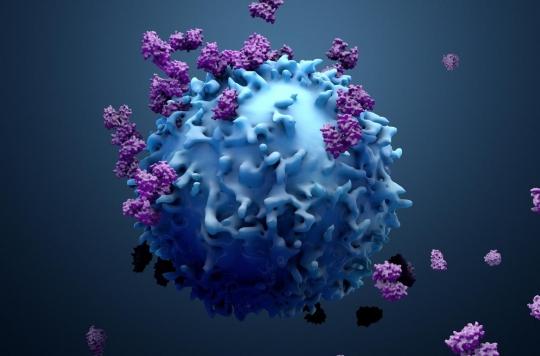A new treatment using near infrared light, coupled with several antibodies, could help manage a rare form of lung cancer, malignant pleural mesothelioma.

- Near-infrared photo-immunotherapy (NIR-PIT) as a treatment strategy for malignant pleural mesothelioma has been shown to be effective in destroying cancer cells
- For this method to be effective, they inject an antibody, called IR700, which targets a specific structure on the cancer cells and a photo-absorber
- In the particular case of malignant pleural mesothelioma, a rare form of lung cancer, another antibody is used: NZ-1, which targets a specific part of a transmembrane glycoprotein called podoplanin
Malignant pleural mesothelioma (MPM) is a rare type of cancer that affects the lung lining. It is usually diagnosed too late, limiting treatment options. A new method of treatment could well revolutionize patient care. Near infrared irradiation, coupled with a compound, was developed and tested by researchers at the University of Nagoya (Japan). The results, published in the journal cellsare promising.
Several combinations of antibodies to destroy cancer cells
Researchers investigated the effectiveness of near-infrared photo-immunotherapy (NIR-PIT) as a treatment strategy for MPM. For this method to be effective, a cancer-targeting compound must first be injected. It is an antibody that targets a specific structure on cancer cells and a photo-absorber, called IR700. When near-infrared light shines on the cancer-affected part of the body, the compound aggregates on the cancer cell membranes, leading to acute cell rupture and tumor death. “The lungs and chest cavity contain a large amount of air and are therefore very good at transmitting near-infrared light efficientlysays Kazuhide Sato, lead author of the study. The NIR-PIT is a safe phototherapy option that can target a region of interest. The IR700 antibody is also non-toxic to the body in the absence of near infrared light irradiation. We therefore thought that the NIR-PIT could be an effective strategy to control localized MPMs.”
To specifically target MPM cancer cells, the researchers studied another antibody, called NZ-1, which attacks a specific part of a transmembrane glycoprotein called podoplanin. Podoplanin is found on many cell types in the body but is particularly abundant in certain types of cancer cells, including MPM. The team’s research has shown that podoplanin is widely expressed in a variety of MPM cell lines. They found that NZ-1 conjugates well with the photo-absorber IR 700 and that NZ-1-IR700 specifically binds podoplanin on cells in the lab. When podoplanin-positive cells, including MPM cancer cells, were mixed with NZ-1-IR700 and then irradiated with near-infrared light, the cells immediately swelled and ruptured.
New studies to confirm treatment is safe
The researchers then tested their treatment on mice with this type of cancer. They injected NZ-1-IR700 and observed that the compound gradually accumulated in the cancer cells. Bright near-infrared light at the tumor sites then led to a reduction in the fluorescence of the stained cancer cells, indicating that the treatment was working well as an anti-cancer strategy.
Further studies are needed to ensure that the treatment is not harmful to healthy cells. The researchers suggest that a more targeted dose of light could be achieved by shining it into a drainage device inserted into the chest cavity which is normally used anyway in patients with MPM to drain the chest of excess light. liquid.
.















